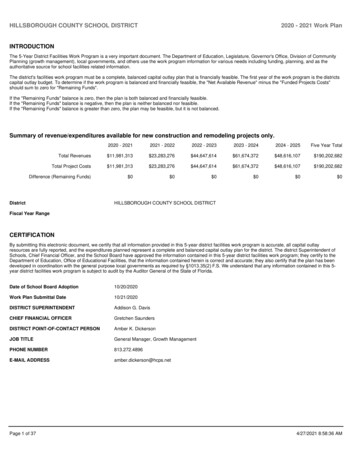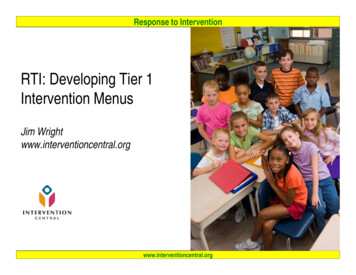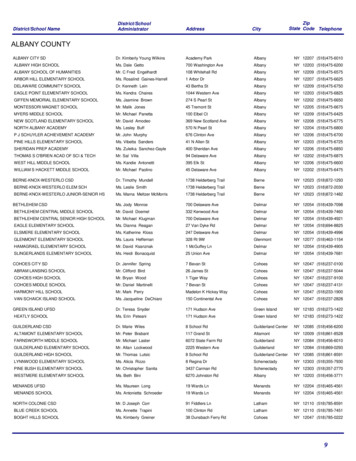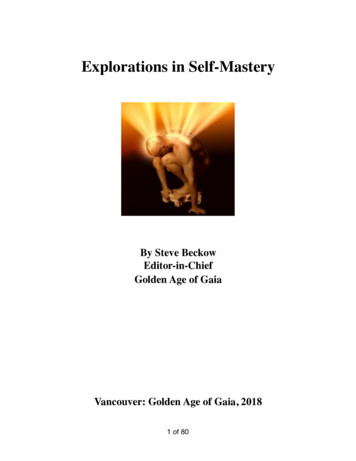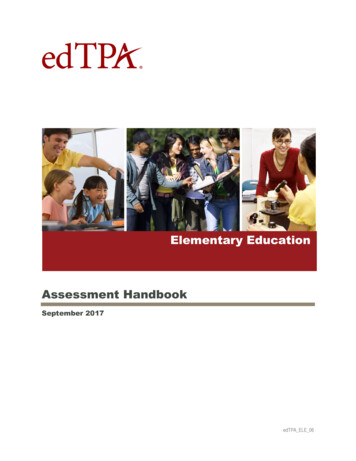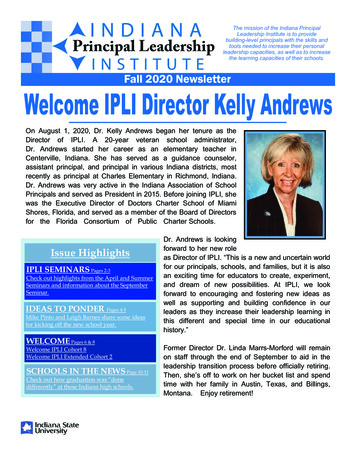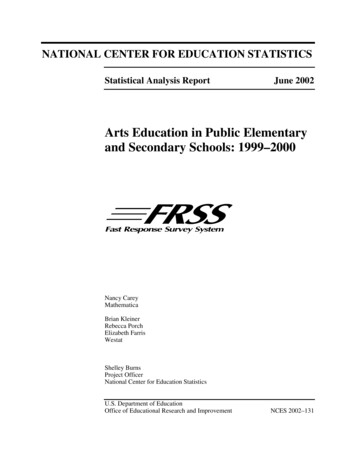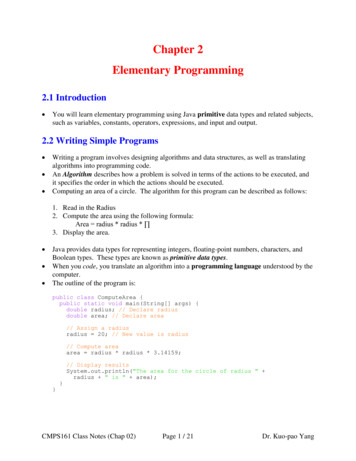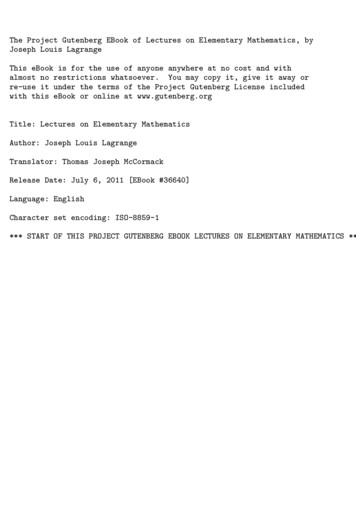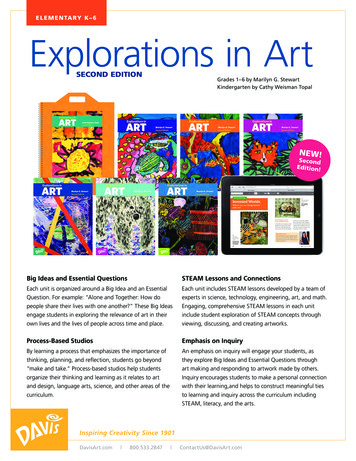
Transcription
E L E M E N TA RY K– 6Explorations in ArtSECOND EDITIONGrades 1–6 by Marilyn G. StewartKindergarten by Cathy Weisman TopalNEW!Sec o n dEdition!Big Ideas and Essential QuestionsSTEAM Lessons and ConnectionsEach unit is organized around a Big Idea and an EssentialQuestion. For example: “Alone and Together: How dopeople share their lives with one another?” These Big Ideasengage students in exploring the relevance of art in theirown lives and the lives of people across time and place.Each unit includes STEAM lessons developed by a team ofexperts in science, technology, engineering, art, and math.Engaging, comprehensive STEAM lessons in each unitinclude student exploration of STEAM concepts throughviewing, discussing, and creating artworks.Process-Based StudiosEmphasis on InquiryBy learning a process that emphasizes the importance ofthinking, planning, and reflection, students go beyond“make and take.” Process-based studios help studentsorganize their thinking and learning as it relates to artand design, language arts, science, and other areas of thecurriculum.An emphasis on inquiry will engage your students, asthey explore Big Ideas and Essential Questions throughart making and responding to artwork made by others.Inquiry encourages students to make a personal connectionwith their learning,and helps to construct meaningful tiesto learning and inquiry across the curriculum includingSTEAM, literacy, and the arts.Inspiring Creativity Since 1901DavisArt.com 800.533.2847 ContactUs@DavisArt.com
PROGR AM COMPONENTSKindergartenYou’ll love teaching Kindergarten with this child-centered, carefullystructured program. Experience, along with your students, the delightof discovering materials, developing skills, and inventing new ways tocreate. Field-tested, effective classroom management techniquesare included in each lesson.Teacher Edition, Unit 2, Lesson 2Big Book, KindergartenThe Big Book includes: Carefully chosen works of fine art andphotographs of the world around us tohelp spark children’s interest andenthusiasm. Simple text to introduce basic concepts. Step-by-step, clearly illustrated Studio Explorations to help children discovertheir own creativity. Sidebars to reinforce techniques, o fferbackground, or remind children of expectations.2Explorations in Art, 2nd Edition, Grades K–6Photos & IllustrationsLessonPhotographs and illustrationsdemonstrate teacher technique,classroom seating, students atwork, and other helpful content.Each Big Book lesson beginswith art images and questions toencourage exploration.
Teacher Edition:Studio ExplorationEach Big Book lesson ends with a Studio Exploration. Clear, illustratedexamples and directions help children explore while ensuring anopportunity for individual expression and problem-solving. Includes classroom-tested approachesto early encounters with materials andprocesses. Gets you ready to teach with materialslists, vocabulary, age-appropriateobjectives, and set-up suggestions. Takes you step by step through each partof the lesson: engaging students at thestart, suggesting questions and commentsto promote idea-sharing, pointing outpotential challenges, and more. Offers ongoing assessment suggestions aswell as scoring rubrics. Provides tips for making each lesson moresuccessful, manageable, and enjoyable. Suggests variations and extensions tolengthen or deepen instruction. Includes illustrations and photographsof classroom situations and children’sartwork.Teaching TipsTeaching Tips include safety tips; ways tochallenge and engage students; support fordifferentiated instruction; classroom managementtip; games; and ways to include the classroomteacher.Student ArtworkExamples of student artwork and quotationsare included throughout.Variations / ExtensionsVariations/Extensions are included with eachlesson. Here, the suggestion of using alternativemedia provides flexibility and options forexploration and experimentation.Lesson ResourcesChildren’s Trade Books arerecommended for each lesson.Davis PublicationsDavisArt.com3
PROGR AM COMPONENTSStudent BooksGrades 1–6Dazzle your students with: Brilliant fine art images 54 studios with stellar examples of student artwork Art criticism that focuses on response and reflection Artist biographies Helpful technique illustrations Student Handbook with examples of elements and principles And much more!Student Book, Grade 3Student Book, Grade 1, Unit 1Student Book , Grade 3, Unit 3Also available as Big Book and eBooks.Big Book (GRADE K)eBook (GRADES K–6)The Student eBook includes brilliant pop-ups for every art image, with theability to magnify each image to 300%. Great for focusing on texture andtechnique. Many other features are included, such as the ability to do aquick search for any key word, including artist, element, principle, or image.4Explorations in Art, 2nd Edition, Grades K–6
Six Units Based on Big Ideas and Essential QuestionsBIG IDEAS Each Student Book includes six units,ESSENTIAL QUESTIONS Essential Questions promoteeach organized around a Big Idea relevant to students’ lives.student inquiry, reflection, and exploration. Each unitThese Big Ideas foster meaningful connections to artworksencourages students to explore Essential Questions thatacross time and place. Elements and principles are embeddedexplore Big Ideas that unite all people—from around thethroughout each unit to ensure continual application andworld and across time.understanding.Big IdeaAlone and TogetherEssential QuestionHow do people share theirlives with one another?Strand 1:Investigate the look andfeelings of the individual.Strand 2:I nvestigate the look andfeelings of people in action.Strand 3:I nvestigate the look andfeelings of people in places.STEAMEach unit ends with acomprehensive, engagingSTEAM lesson.Student Book, Grade 3, Unit 1Davis PublicationsDavisArt.com5
PROGR AM COMPONENTSTeacher EditionGrades 1–6Each Teacher Edition includesa wealth of useful teaching support designed to helpteachers pick and choose.Teacher Edition, Grade 3, Unit 1, Lesson 1.5Teacher Edition, Grade 3Some of the many featuresof teaching support include: Support for differentiatedinstruction STEAM and cross-curricular links Suggestions for Children’sTrade Books for each lesson Biographies of featured artists Evaluation criteria for each studio Rubrics, informal assessment checklists,and performance tasks And much more!NOTE: Each eBook purchase includesboth the Student Book and theTeacher Edition.6Explorations in Art, 2nd Edition, Grades K–6PrepareIncludes three lessonobjectives that relateto the theme, the artconcepts, and the studio.Teach throughInquiryIncludes Engage,Explore, and Create.AssessTips for formative,informal assessmentare included at theend of each lesson.
Differentiated InstructionDifferentiated Instruction includes tips for five categoriesof learners: Extra Help, Advanced, Spanish Speakers,English Language Learners, and Special Needs.About the ArtistBiographical information is included in theTeacher Edition for each featured artist.STEAMSTEAM connections include connecting artinstruction to science, technology, engineering,and math.Children’s Trade BooksSuggested children’s trade books are includedwith each lesson.Reading Comprehension andConnections across the ArtsConnections Across the Curriculum includeConnections Across Reading and LanguageArts, Social Studies, and Across the Arts.Quick Question ReviewA quick way for students to review what they’velearned. Questions are designed to be quickand easy, and to promote Every Pupil Responseto encourage participation by all students.CloseEach lesson closes with support forencouraging students to continuethinking about the lesson’s artcontent and Essential Question.Explore theEssential QuestionEach lesson ends with an opportunityfor students to continue to explore theEssential Question and Big Ideas.Aesthetic AwarenessEach lesson ends with a suggestion forencouraging students to view their world likean artist, and to look for the concepts theylearned about in the world around them.Davis PublicationsDavisArt.com7
GR ADES 1– 6UNIT STRUC TUREUnit Planning Guide & ResourcesA clear Unit Planning Guide provides an overview of each lesson in the unit, including the artworks, studios, vocabulary,materials, cross-curricular connections, and suggested Children’s Trade Books to enrich and extend each lesson.Teacher Edition, Grade 3, Unit 1, Planning GuideDigital Fine Art ImagesEach eBook purchase includes unlimitedaccess for you and your students to theDavis Digital Fine Art Library of more than35,000 images.Print book purchasers can easily include alow-cost subscription to the Davis DigitalFine Art Library.Teachers and students can easily choosecorrelated images by lesson, or conducttheir own search by artist, element, principle,medium, culture, or other key words.Teachers and students can tag images tocreate specialized sets by class or concept.They can easily compare and contrast anytwo images.8Explorations in Art, 2nd Edition, Grades K–6
Each unit includes engaging resources to extend the lessons.Cross-CurricularConnectionscan be taught by the art educator, classroomteacher, or a content area specialist.STEAM Art CardIncludes six copies of the STEAM ArtCard for the unit. Cards are 8 ½ x 11"on heavy stock.Artist andVocabulary Cardsare in both English and Spanish.Allows for group work and furtherexploration of the STEAM lesson.Teacher Edition,Grade 3, Unit 1ResourcesDavis PublicationsDavisArt.com9
GR ADES 1– 6UNIT STRUC TUREUnit IntroductionTeacher Edition, Grade 3, Unit 1 IntroductionThe Unit Introduction beginseach unit and helps theteacher introduce the unittheme and learning objectivesto students.Introduce the UnitTeaching support forintroducing the unit’s BigIdea, Essential Question, andObjectives is included at thebeginning of each unit.Introduce theBig IdeaSupport to help teachersintroduce the Big Idea.Human ExperienceEach unit is organized aroundan Enduring Idea that is sharedby all people across time andplace.Art, Design, andHuman ExperienceEach unit focuses on how artists across timeand place have experienced the unit’s Big Idea.10Explorations in Art, 2nd Edition, Grades K–6
Learn about the unit structure in each Student Book andTeacher Edition, as you view these pages from Grade 3, Unit 1.Unit ObjectivesEach unit is organized aroundfour learning objectives:Learn about artworks.Students learn the significantrole that art plays in our livesand in society.Learn how artists anddesigners communicate.Students learn how artistsand designers communicateideas using the elements ofart, principles of design, skillsand techniques, and formsand media.Experience the Big Ideaas artists and designers.The nine studio explorationsin each unit provide anopportunity for students toexpress their understandingof the unit’s Big Idea whilepracticing the specific skillsand techniques that artistsuse to communicate.Experience the Big Idea asviewers of art and design.Like creating art, the viewingof art and design is a skill thatcan improve with practice.Each unit includes numerousartworks and examples ofexemplary design from acrosstime and place to help studentslearn how to view and discussartworks and design.Essential QuestionStrandsThe Essential Question helpsstudents explore the Big Idea ineach unit.Each unit is divided into three strands that exploredifferent aspects of the Essential Question.Davis PublicationsDavisArt.com11
GR ADES 1– 6UNIT STRUC TUREStrand 1: First LessonTeacher Edition, Grade 3The first lesson of each unitintroduces the first of threestrands in the unit. Each strandincludes three lessons. Thethird lesson of each strandis a comprehensive StudioExploration.StrandEach unit includes three strands.Each strand provides a specificfocus on the unit’s Big Ideasand Essential Question.PreparePrepare includes LessonObjectives and Materials.Teach throughInquiryEngage helps teachersto activate students’ priorknowledge and to understandthe focus of each lesson.Explore the Images includesquestions and support forhelping students view andreflect on each image. Thefocus is on inquiry, exploration,and reflection.Create includes teachingtips and support for studioinstruction and exploration.12Explorations in Art, 2nd Edition, Grades K–6
Studio TimeEach lesson includes a Studio Time for students to explore the Big Idea andEssential Question, and to practice art and design concepts taught in eachlesson. Each Studio Time includes authentic student artworks.HistoryConnections across thecurriculum include socialstudies, STEM, and ConnectionsAcross the Arts.ReadingComprehensionTeachers will find meaningfulways to connect lessons toreading and language artsinstruction.Process TipProcess Tips help students focuson the process and not simplythe product.DifferentiatedInstructionEach lesson includes support formeeting the individual needs ofstudents. Tips include supportfor English Language Learners,Spanish Speakers, SpecialNeeds, Advanced, and ExtraHelp.Alignment toLanguage ArtsTeachers will find meaningfuland time-efficient ways toconnect lessons to reading andlanguage arts instruction.Children’s Trade BooksChildren’s Trade Books have been chosen for each lesson. These booksare chosen based on three criteria: more about the artist or designer;illustrations that exemplify the art or design concept, such as line orvariety; or information about the lesson content or Big Idea.ConnectionsAcross the ArtsConnections Across the Artsinclude theater, dance, andmusic.Davis PublicationsDavisArt.com13
GR ADES 1– 6UNIT STRUC TUREStrand 1: Second LessonTeacher Edition, Grade 3The second lesson of eachstrand continues explorationof the Big Idea and EssentialQuestion, and the strand’sspecific focus, while introducingnew art and design concepts.StrandEach unit includes three strands.Each strand provides a specificfocus on the unit’s Big Idea andEssential Question.Lesson VocabularyLesson Vocabulary is highlightedin yellow and listed in Englishand Spanish. Definitions arein the Glossary in the StudentHandbook.Teach throughInquiryTeach through Inquiry includesEngage, Explore the Images,and Create: Studio Time.Studio Evaluation CriteriaEvaluation Criteria is included for each studio in theprogram. The reddish brown color indicates assessmentopportunities and support.14Explorations in Art, 2nd Edition, Grades K–6
Differentiated InstructionDifferentiated Instruction tips include tips for English LanguageLearners. Many of these tips serve as built-in professionaldevelopment ideas for addressing the needs of this population.About the ArtistsArtist biographies includeinformation that teacherscan share with students.Visual CultureVisual Culture tips help studentsconnect their learning to visualmessages and culture.STEAMSTEAM connections providequick tips for helping teachersconnect lessons to science,technology, engineering, andmath.Aesthetic AwarenessExplore the Essential QuestionEncourage students to view their worldEach lesson brings students back to exploring thelike an artist or designer, and to look forBig Idea through the Essential Question.the concepts they learned about in theQuick QuestionReviewA quick way for students toreview what they’ve learned.world around them.Davis PublicationsDavisArt.com15
GR ADES 1– 6UNIT STRUC TUREStrand 1: Studio ExplorationTeacher Edition, Grade 3Each strand ends with a StudioExploration. The four-pageStudio Explorations—threeper unit—provide cumulativereinforcement and explorationof lesson concepts.What Ideas WillYou Explore?Students learn the goal of theStudio Exploration and beginto reflect on what they willexplore. Students explore theBig Idea and Essential Question,while also practicing artand design concepts.Teach throughInquiryIntroduce the StudioTeaching support includes aconnection to the unit’s BigIdea, the art concepts thatstudents have learned in thetwo previous lessons, and anintroduction to the goals ofthe studio.16Your ArtworkShould:Teach through InquiryBefore students begin, they knowtheir studio goals and how theirwork will be evaluated.Before students begin their studio, they explore ideas,Explorations in Art, 2nd Edition, Grades K–61. Explorematerials, images, objects, techniques, and tools.
Inspiration from ArtEach Studio Exploration includes Inspiration from Art to inspire studentsbefore they begin their artwork and to demonstrate to students how artistsget ideas from other artists.Art HistoryEach Studio Exploration includesArt History related to theInspiration from Art, includinginformation on the artist andthe artwork.Inspirationfrom Our WorldEach Studio Exploration includesreal-world photos to helpstudents plan their artworksand to demonstrate to studentshow artists get ideas fromobserving their world.Studio Evaluation CriteriaThe built-in Studio Evaluation Criteria is included in the Student Book(Things to Remember) as well as in the Teacher Edition.Davis PublicationsDavisArt.com17
GR ADES 1– 6UNIT STRUC TUREStrand 1: Studio ExplorationcontinuedTeacher Edition, Grade 3The last two pages of eachStudio Exploration includeSteps 2–5, four techniqueillustrations, and an ArtCriticism feature based onauthentic student artwork.Teach throughInquiryTeaching support includespractical tips and suggestionsfor guiding students.2. CreateFour technique illustrationsto model the use of materialsand tools.3. Reflect and ReviseStudents are encouraged torevise their artworks as theyrevisit the studio evaluationcriteria they previewed inThings to Remember.4. Finish UpStudents are encouraged tothink about their artwork onelast time before they considerit complete.5. Reflect and PresentStudents learn more abouttheir artworks by sharingwith their classmates. Theylearn the importance ofreflecting on what they havelearned about themselves asartists, and what techniques,materials, forms, and mediathey may use in the future.18AssessAssessment RubricIn addition to the Assessment Rubric, Assessgives teachers additional options for assessingstudents through their discussions, their criticalviewing, and referring back to the StudioEvaluation Criteria for their artworks.Studio-specific Evaluation Criteria, as wellas criteria for assessing learning for thecomplete strand, including the two lessonsthat precede the Studio Exploration.Explorations in Art, 2nd Edition, Grades K–6
For Your Research JournalStudents are encouraged to keep a Research Journal with sketches,ideas, and reflections, and to view the role of an artist as a researcher.Art CriticismPossible AnswersPossible answers are includedin the Teacher Edition.Art CriticismArt Criticism based on studentartwork provides students witha safe model for peer revisionand assessment.Portfolio TipPortfolio Tips provide practicalsuggestions for keeping aportfolio, and encouragingstudents to reflect onthemselves as artists anddesigners, what they havelearned, and their goals forfuture artworks.Cross-CurricularConnectionsThe Teacher Edition includes awealth of connections acrossthe curriculum, includingReading and Language Arts,STEM, Social Studies, andConnections Across the Arts.ClosePresentingEach lesson ends with a three-part Close: theQuick Question Review, Aesthetic Awareness,and Explore the Essential Question.Each Studio Exploration includesideas for presenting students’ artworks.Davis PublicationsDavisArt.com19
GR ADES 1– 6UNIT STRUC TURESTEAMTeacher Edition, Grade 3Each unit includes acomprehensive STEAMlesson. Students explorethe importance of science,technology, engineering, andmath in creating artworks.Focus on . . .Each lesson focuses on science,technology, engineering, ormath.Engaging ArtworkEach lesson focuses on onetwenty-first century artworkto prompt discussion, analysis,exploration, and reflection.These images are available onSTEAM Art cards, 8 ½ x 11" onheavy stock. There are six cardsfor each image to encouragesmall group exploration anddiscussion.Look and RespondQuestions encourage student explorationof STEAM concepts.20Explorations in Art, 2nd Edition, Grades K–6
Process ImagesProcess images encourage students to explore the STEAM concepts that contribute to thecreation of each artwork. These images are on the back of each STEAM Art card. On thefront of each card is the completed artwork that appears on the first page of the lesson.Research andCollaborateHands-on research encouragesinquiry and exploration.STEAM ConnectionsThe Teacher Edition includesconnections to science,technology, engineering, andmath, designed to supportthe art educator help studentsexplore these domains.Create, Reflect,ReviseEach lesson includes aSTEAM studio.Research JournalSTEAM lessons demonstrate that artistsand designers are researchers, exploringdifferent materials, techniques, tools, andways to solve art and design problems.Davis PublicationsDavisArt.com21
GR ADES 1– 6UNIT STRUC TUREUnit ReviewTeacher Edition, Grade 3Each Unit Review includes areview of vocabulary and keyconcepts. These are designedto provide a variety of optionsbased on your time constraintsand classroom needs.Unit ReviewIn the Unit Review, studentsreview the Unit Objectives,including the Big Idea andEssential Question, as wellas Art and Design concepts.Unit PerformanceTasksEach unit concludes withopportunities for studentsto demonstrate theirunderstanding throughengaging performance tasks.Writing About ArtWriting prompts extend artconcepts.Critical ThinkingCritical thinking questionsencourage higher-levelthinking, analysis, exploration,and reflection.Art CriticismEach Unit Review includes an Art Criticism opportunity. Questionsprovide an opportunity for students to demonstrate their understandingof the Big Idea, as well as specific art concepts. This is one of four ArtCriticism opportunities in each unit.22Explorations in Art, 2nd Edition, Grades K–6
Unit AssessmentRubricA comprehensive AssessmentRubric addresses the four unitobjectives. These unit objectivesare introduced to students inthe Unit Introduction.Davis PublicationsDavisArt.com23
PROGR AM COMPONENTSDavis DigitalAncillariesExplorations in Art is also available onExplorations in Art ancillaries are designed to provide a wealth ofDavis Digital, a cloud-based platformuseful teaching support to help teachers pick and choose easily.designed specifically for K–12 art educators.Ancillaries include:Davis Digital includes access to the sameResource Cards include 36 STEAM Art Cards with ExplorationHandouts, 30 Vocabulary Cards, and 30 Artist Cards for each level.high-quality content and images containedin the print versions of our textbooks, but STEAM Art Cards: six copies of each STEAM lesson allowteachers to easily organize students into small groups fordiscussion, collaboration, and problem-solving.with added features and flexibility.eBooks: Each eBook purchase includes theStudent Book, the Teacher Edition, and theReproducible Masters. STEAM Exploration Handouts: worksheets to supportassessment and guide small group explorations. Artist Cards: artist picture on one side, and a biography inEnglish and Spanish on the other side.Davis Art Images Subscription: The fine artin each eBook is now extended with access tomore than 35,000 digital fine art images fromaround the globe and across time. Vocabulary Cards: a picture prompt on one side highlightingan art vocabulary word or concept, and the vocabulary wordor expression on the other side in both English and Spanish.Fine Art Pop-up: Click on any fine art imagein the Student Book to open a pop-up.The Teacher Resource Package contains even more supportfor both students and teachers including:Curriculum Builder: A lesson planning andpresentation tool that allows you to gatherthe content you need in one place.Student Handouts Pre-Assessments Compare and Contrast Art Criticism Unit Review AssessmentsPortfolios: You and your students can createonline portfolios. Share your portfolios withparents, classmates, and colleagues.Student Accounts: Options include 30, 60,or 200 Student Accounts with the purchaseof each eBook.Artroom Reference Sheets Art Safety Color Elements of Art Principles of DesignInspiring Creativity Since 1901DavisArt.com 800.533.2847 ContactUs@DavisArt.comResources for Teachers Studio Exploration Rubrics Artist Biographies Glossary (English and Spanish) Improving English Language Skills
Explorations in Art, 2nd Edition, Grades K-6 . Student Book, Grade 3. t 3. Student Book, Grade 1, Unit 1. Dazzle your students with: Brilliant fine art images 54 studios with stellar examples of student artwork Art criticism that focuses on response and reflection Artist biographies Helpful technique illustrations
